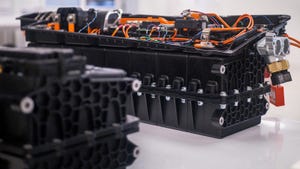Thermoforming processors of large automotive or industrial parts who are keen to knock metal off its perch have a new tool to work with as the Penn Fibre division of Ensinger has expanded its product range, adding long-glass-fiber-reinforced polyolefin sheet to its quiver.
July 21, 2010
Ensinger is one of the world's largest suppliers of semi-finished plastic parts. Its Penn Fibre division, based in Bensalem, PA, now offers thermoformable long-glass-fiber (LGF) polyolefin-based sheet as part of its Pennite-brand sheet product line. The sheet is available with glass-fiber loadings ranging from 20-35%.
The company already offers a range of sheet reinforced with short-glass fibers. LGF-reinforced sheets do not sag as much and also bring with them improved physical properties. Penn Fibre General Manager, John Cowperthwait, said, "We produce short-glass-fiber products in crystalline resins such as nylon, PEEK, PPS, and amorphous polymers such as Ultem PEI all the time. What we did not know was whether we could get this into a sheet with the fiber intact, and whether the sheet would be thermoformable using conventional thermoforming equipment."
Testing by processor Maryland Thermoform (Baltimore, MD), verified that the 0.125-inch thick LGF-loaded sheet formed well. The processor's Tammy Sagastume, sales manager, says the company already has a lot of customer interest in a variety of applications that can take advantage of the new sheet's heightened properties. These include its improved strength and stiffness, as well as improved impact, creep, and fatigue resistance relative to short-glass-fiber compounds, particularly as metal replacement for automotive products.
Applications in the automotive markets could include: cross-car beams; battery trays; instrument-panel substrates; fender supports; face shields; seat backs; fan shrouds; load floors; and bumper beams. Maybe more likely will be its use in markets that have lower-volume production needs, such as panels and other parts for golf carts, snowmobiles, mobile homes, RVs, motorcycles, construction, truck and bus, aircraft, and marine applications. —[email protected]
About the Author(s)
You May Also Like


